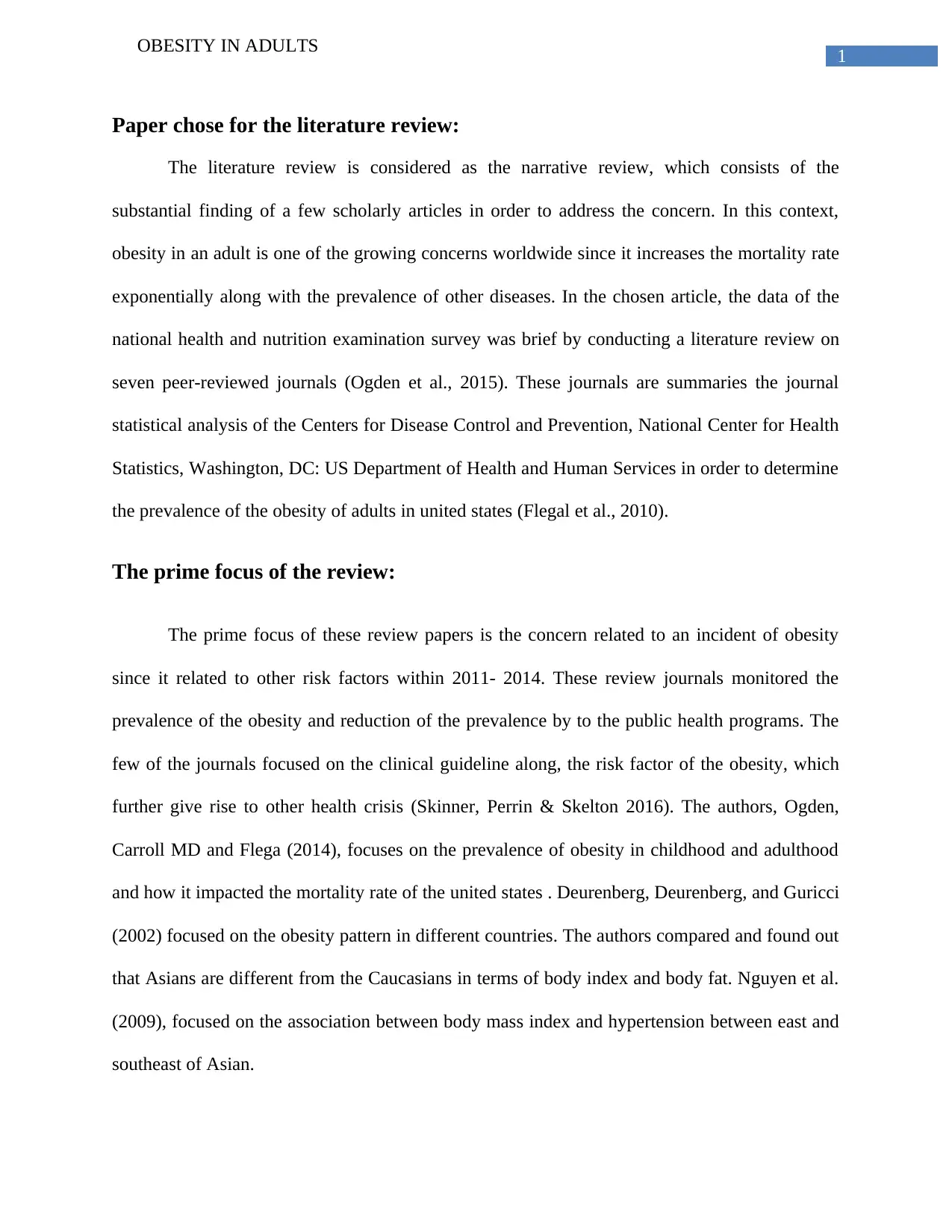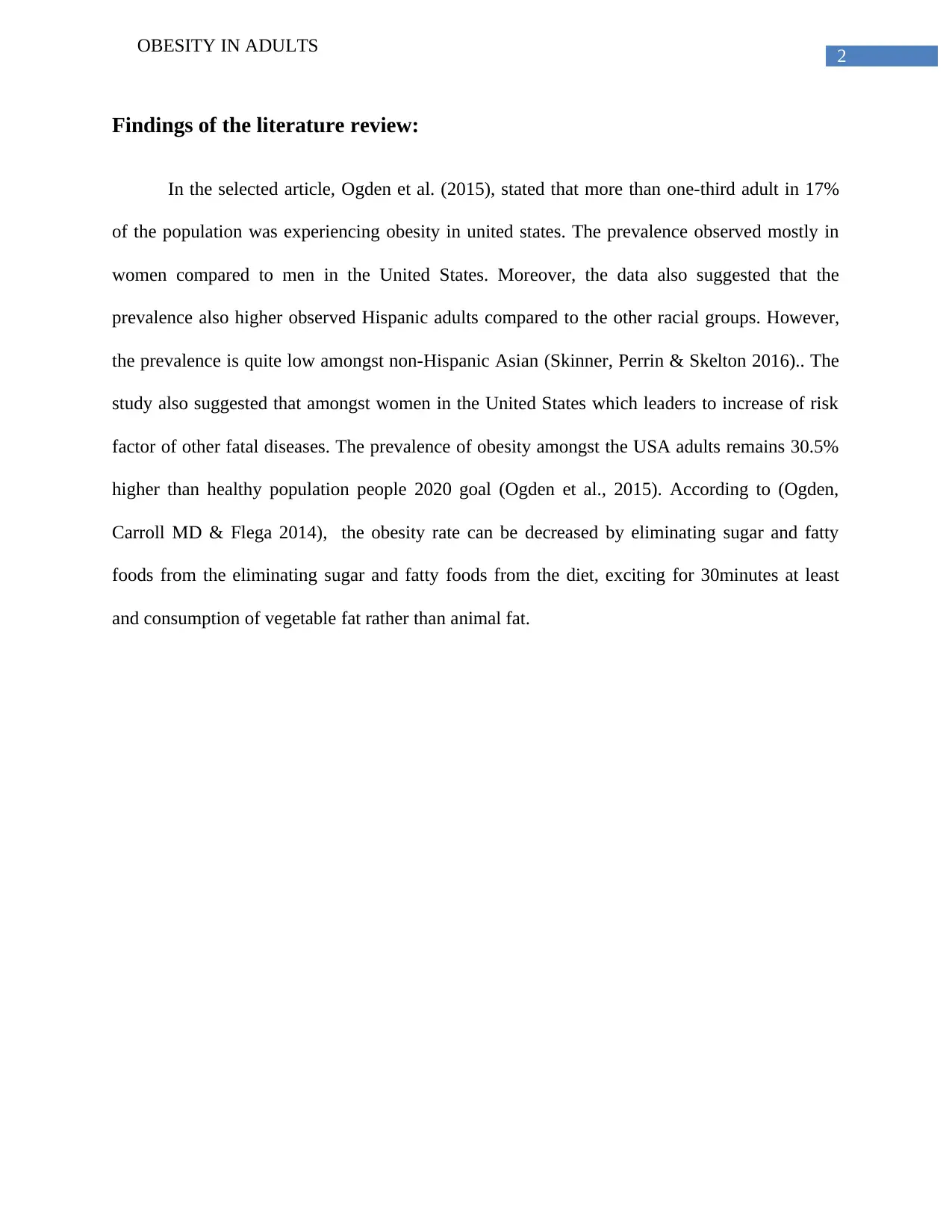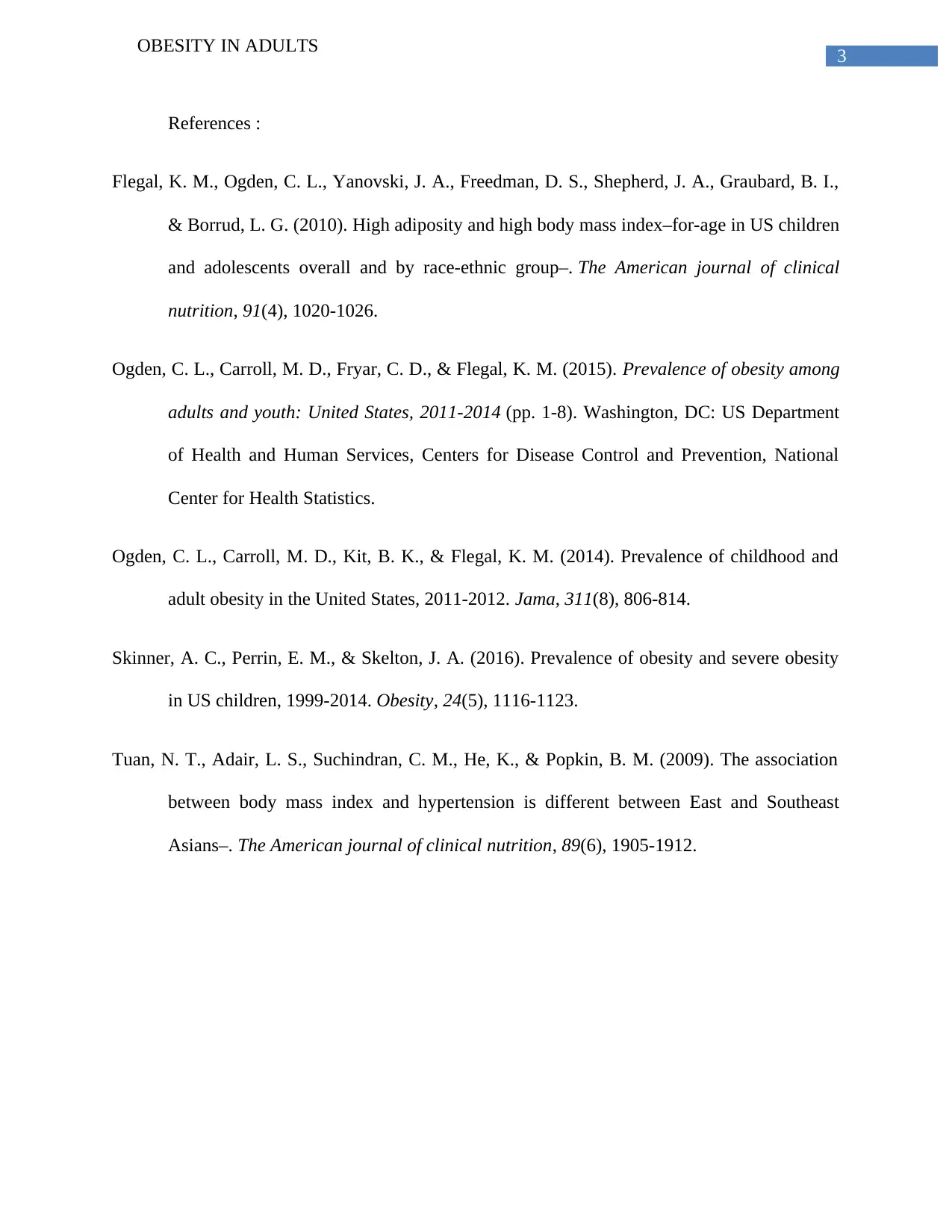Adult Obesity in the US: A Literature Review of Health Data
VerifiedAdded on 2023/06/03
|4
|859
|361
Literature Review
AI Summary
This literature review examines the growing concern of adult obesity, focusing on its prevalence and impact on mortality rates. It analyzes data from the National Health and Nutrition Examination Survey and other peer-reviewed journals to determine the prevalence of obesity in adults in the United States. The review highlights the correlation between obesity and other risk factors, particularly among women and certain racial groups. It also discusses potential strategies for reducing obesity rates, such as dietary changes and increased physical activity. This document is available on Desklib, where students can find more solved assignments and study resources.

Running head: OBESITY IN ADULTS
Obesity in adults
Name of the student:
Name of the university:
Author note:
Obesity in adults
Name of the student:
Name of the university:
Author note:
Paraphrase This Document
Need a fresh take? Get an instant paraphrase of this document with our AI Paraphraser

1
OBESITY IN ADULTS
Paper chose for the literature review:
The literature review is considered as the narrative review, which consists of the
substantial finding of a few scholarly articles in order to address the concern. In this context,
obesity in an adult is one of the growing concerns worldwide since it increases the mortality rate
exponentially along with the prevalence of other diseases. In the chosen article, the data of the
national health and nutrition examination survey was brief by conducting a literature review on
seven peer-reviewed journals (Ogden et al., 2015). These journals are summaries the journal
statistical analysis of the Centers for Disease Control and Prevention, National Center for Health
Statistics, Washington, DC: US Department of Health and Human Services in order to determine
the prevalence of the obesity of adults in united states (Flegal et al., 2010).
The prime focus of the review:
The prime focus of these review papers is the concern related to an incident of obesity
since it related to other risk factors within 2011- 2014. These review journals monitored the
prevalence of the obesity and reduction of the prevalence by to the public health programs. The
few of the journals focused on the clinical guideline along, the risk factor of the obesity, which
further give rise to other health crisis (Skinner, Perrin & Skelton 2016). The authors, Ogden,
Carroll MD and Flega (2014), focuses on the prevalence of obesity in childhood and adulthood
and how it impacted the mortality rate of the united states . Deurenberg, Deurenberg, and Guricci
(2002) focused on the obesity pattern in different countries. The authors compared and found out
that Asians are different from the Caucasians in terms of body index and body fat. Nguyen et al.
(2009), focused on the association between body mass index and hypertension between east and
southeast of Asian.
OBESITY IN ADULTS
Paper chose for the literature review:
The literature review is considered as the narrative review, which consists of the
substantial finding of a few scholarly articles in order to address the concern. In this context,
obesity in an adult is one of the growing concerns worldwide since it increases the mortality rate
exponentially along with the prevalence of other diseases. In the chosen article, the data of the
national health and nutrition examination survey was brief by conducting a literature review on
seven peer-reviewed journals (Ogden et al., 2015). These journals are summaries the journal
statistical analysis of the Centers for Disease Control and Prevention, National Center for Health
Statistics, Washington, DC: US Department of Health and Human Services in order to determine
the prevalence of the obesity of adults in united states (Flegal et al., 2010).
The prime focus of the review:
The prime focus of these review papers is the concern related to an incident of obesity
since it related to other risk factors within 2011- 2014. These review journals monitored the
prevalence of the obesity and reduction of the prevalence by to the public health programs. The
few of the journals focused on the clinical guideline along, the risk factor of the obesity, which
further give rise to other health crisis (Skinner, Perrin & Skelton 2016). The authors, Ogden,
Carroll MD and Flega (2014), focuses on the prevalence of obesity in childhood and adulthood
and how it impacted the mortality rate of the united states . Deurenberg, Deurenberg, and Guricci
(2002) focused on the obesity pattern in different countries. The authors compared and found out
that Asians are different from the Caucasians in terms of body index and body fat. Nguyen et al.
(2009), focused on the association between body mass index and hypertension between east and
southeast of Asian.

2
OBESITY IN ADULTS
Findings of the literature review:
In the selected article, Ogden et al. (2015), stated that more than one-third adult in 17%
of the population was experiencing obesity in united states. The prevalence observed mostly in
women compared to men in the United States. Moreover, the data also suggested that the
prevalence also higher observed Hispanic adults compared to the other racial groups. However,
the prevalence is quite low amongst non-Hispanic Asian (Skinner, Perrin & Skelton 2016).. The
study also suggested that amongst women in the United States which leaders to increase of risk
factor of other fatal diseases. The prevalence of obesity amongst the USA adults remains 30.5%
higher than healthy population people 2020 goal (Ogden et al., 2015). According to (Ogden,
Carroll MD & Flega 2014), the obesity rate can be decreased by eliminating sugar and fatty
foods from the eliminating sugar and fatty foods from the diet, exciting for 30minutes at least
and consumption of vegetable fat rather than animal fat.
OBESITY IN ADULTS
Findings of the literature review:
In the selected article, Ogden et al. (2015), stated that more than one-third adult in 17%
of the population was experiencing obesity in united states. The prevalence observed mostly in
women compared to men in the United States. Moreover, the data also suggested that the
prevalence also higher observed Hispanic adults compared to the other racial groups. However,
the prevalence is quite low amongst non-Hispanic Asian (Skinner, Perrin & Skelton 2016).. The
study also suggested that amongst women in the United States which leaders to increase of risk
factor of other fatal diseases. The prevalence of obesity amongst the USA adults remains 30.5%
higher than healthy population people 2020 goal (Ogden et al., 2015). According to (Ogden,
Carroll MD & Flega 2014), the obesity rate can be decreased by eliminating sugar and fatty
foods from the eliminating sugar and fatty foods from the diet, exciting for 30minutes at least
and consumption of vegetable fat rather than animal fat.
⊘ This is a preview!⊘
Do you want full access?
Subscribe today to unlock all pages.

Trusted by 1+ million students worldwide

3
OBESITY IN ADULTS
References :
Flegal, K. M., Ogden, C. L., Yanovski, J. A., Freedman, D. S., Shepherd, J. A., Graubard, B. I.,
& Borrud, L. G. (2010). High adiposity and high body mass index–for-age in US children
and adolescents overall and by race-ethnic group–. The American journal of clinical
nutrition, 91(4), 1020-1026.
Ogden, C. L., Carroll, M. D., Fryar, C. D., & Flegal, K. M. (2015). Prevalence of obesity among
adults and youth: United States, 2011-2014 (pp. 1-8). Washington, DC: US Department
of Health and Human Services, Centers for Disease Control and Prevention, National
Center for Health Statistics.
Ogden, C. L., Carroll, M. D., Kit, B. K., & Flegal, K. M. (2014). Prevalence of childhood and
adult obesity in the United States, 2011-2012. Jama, 311(8), 806-814.
Skinner, A. C., Perrin, E. M., & Skelton, J. A. (2016). Prevalence of obesity and severe obesity
in US children, 1999‐2014. Obesity, 24(5), 1116-1123.
Tuan, N. T., Adair, L. S., Suchindran, C. M., He, K., & Popkin, B. M. (2009). The association
between body mass index and hypertension is different between East and Southeast
Asians–. The American journal of clinical nutrition, 89(6), 1905-1912.
OBESITY IN ADULTS
References :
Flegal, K. M., Ogden, C. L., Yanovski, J. A., Freedman, D. S., Shepherd, J. A., Graubard, B. I.,
& Borrud, L. G. (2010). High adiposity and high body mass index–for-age in US children
and adolescents overall and by race-ethnic group–. The American journal of clinical
nutrition, 91(4), 1020-1026.
Ogden, C. L., Carroll, M. D., Fryar, C. D., & Flegal, K. M. (2015). Prevalence of obesity among
adults and youth: United States, 2011-2014 (pp. 1-8). Washington, DC: US Department
of Health and Human Services, Centers for Disease Control and Prevention, National
Center for Health Statistics.
Ogden, C. L., Carroll, M. D., Kit, B. K., & Flegal, K. M. (2014). Prevalence of childhood and
adult obesity in the United States, 2011-2012. Jama, 311(8), 806-814.
Skinner, A. C., Perrin, E. M., & Skelton, J. A. (2016). Prevalence of obesity and severe obesity
in US children, 1999‐2014. Obesity, 24(5), 1116-1123.
Tuan, N. T., Adair, L. S., Suchindran, C. M., He, K., & Popkin, B. M. (2009). The association
between body mass index and hypertension is different between East and Southeast
Asians–. The American journal of clinical nutrition, 89(6), 1905-1912.
1 out of 4
Related Documents
Your All-in-One AI-Powered Toolkit for Academic Success.
+13062052269
info@desklib.com
Available 24*7 on WhatsApp / Email
![[object Object]](/_next/static/media/star-bottom.7253800d.svg)
Unlock your academic potential
Copyright © 2020–2025 A2Z Services. All Rights Reserved. Developed and managed by ZUCOL.





